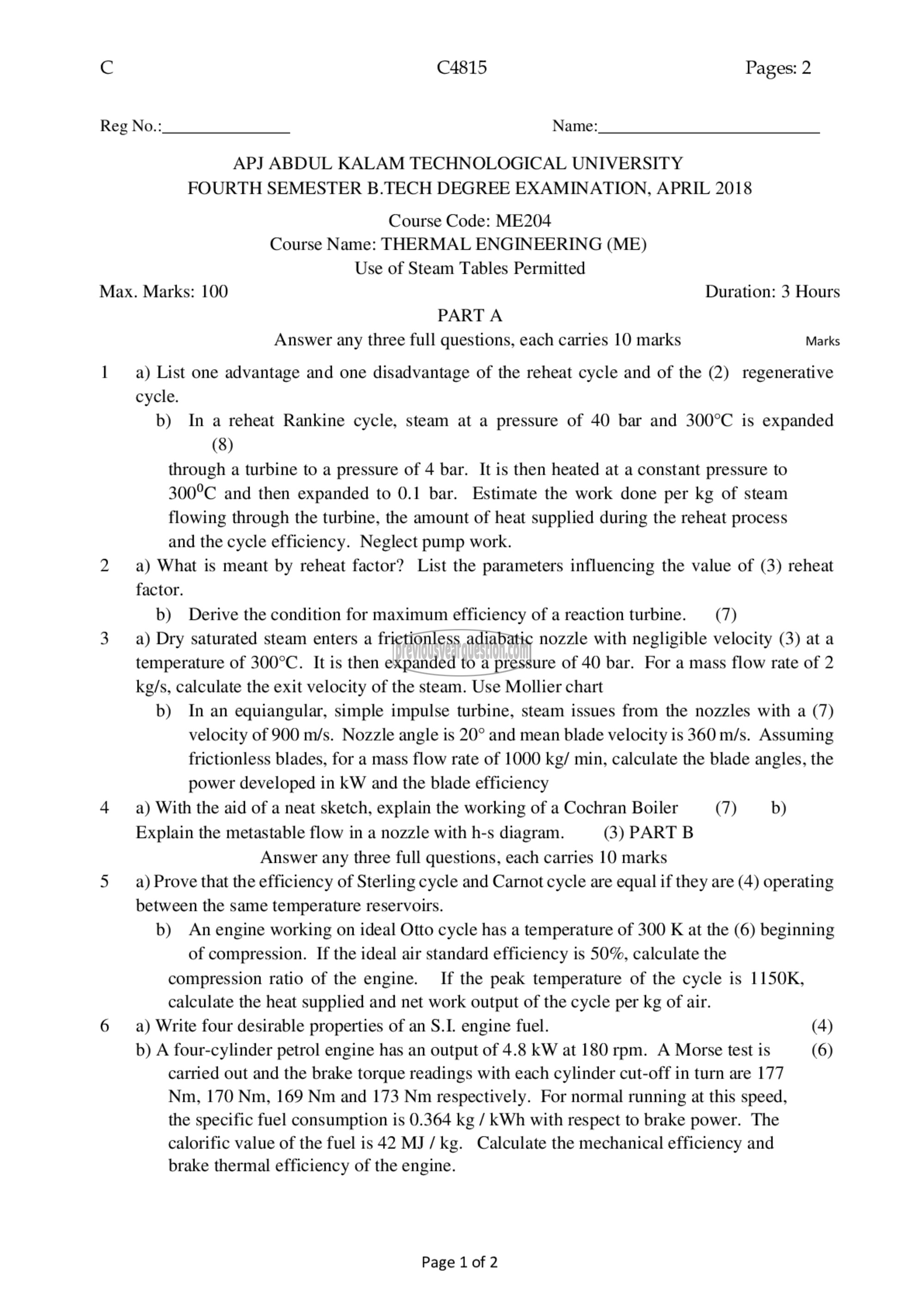APJ ABDUL KALAM TECHNOLOGICAL UNIVERSITY Previous Years Question Paper & Answer
Semester : SEMESTER 4
Subject : Thermal Engineering
Year : 2018
Term : APRIL
Branch : MECHANICAL ENGINEERING
Scheme : 2015 Full Time
Course Code : ME 204
Page:1
60 C4815 Pages: 2
Reg No.: Name:
APJ ABDUL KALAM TECHNOLOGICAL UNIVERSITY
FOURTH SEMESTER B.TECH DEGREE EXAMINATION, APRIL 2018
Course Code: ME204
Course Name: THERMAL ENGINEERING (ME)
Use of Steam Tables Permitted
Max. Marks: 100 Duration: 3 Hours
PART A
Answer any three full questions, each carries 10 marks Marks
1 8) List one advantage and one disadvantage of the reheat cycle and of the (2) regenerative
cycle.
b) In a reheat Rankine cycle, steam at a pressure of 40 bar and 300°C is expanded
(8)
through a turbine to a pressure of 4 bar. It is then heated at a constant pressure to
300°C and then expanded to 0.1 bar. Estimate the work done per kg of steam
flowing through the turbine, the amount of heat supplied during the reheat process
and the cycle efficiency. Neglect pump work.
2 a) What is meant by reheat factor? List the parameters influencing the value of (3) reheat
factor.
b) Derive the condition for maximum efficiency of a reaction turbine. (7)
3 8) Dry saturated steam enters a frictionless adiabatic nozzle with negligible velocity (3) at ೩
temperature of 300°C. It is then expanded to a pressure of 40 bar. For a mass flow rate of 2
kg/s, calculate the exit velocity of the steam. Use Mollier chart
b) In an equiangular, simple impulse turbine, steam issues from the nozzles with a (7)
velocity of 900 m/s. Nozzle angle is 20° and mean blade velocity is 360 m/s. Assuming
frictionless blades, for a mass flow rate of 1000 kg/ min, calculate the blade angles, the
power developed in kW and the blade efficiency
4 १) With the aid of a neat sketch, explain the working of a Cochran Boiler (7) b)
Explain the metastable flow in a nozzle with h-s diagram. (3) PART B
Answer any three full questions, each carries 10 marks
5 (ہ- Prove that the efficiency of Sterling cycle and Carnot cycle are equal if they are (4) operating
between the same temperature reservoirs.
b) An engine working on ideal Otto cycle has a temperature of 300 K at the (6) beginning
of compression. If the ideal air standard efficiency is 50%, calculate the
compression ratio of the engine. If the peak temperature of the cycle is 1150K,
calculate the heat supplied and net work output of the cycle per kg of air.
6 a) Write four desirable properties of an 5.1 engine fuel. (4)
b) A four-cylinder petrol engine has an output of 4.8 kW at 180 rpm. A Morse test is (6)
carried out and the brake torque readings with each cylinder cut-off in turn are 177
Nm, 170 Nm, 169 Nm and 173 Nm respectively. For normal running at this speed,
the specific fuel consumption is 0.364 kg / kWh with respect to brake power. The
calorific value of the fuel is 42 MJ / kg. Calculate the mechanical efficiency and
brake thermal efficiency of the engine.
Page 1 of 2
